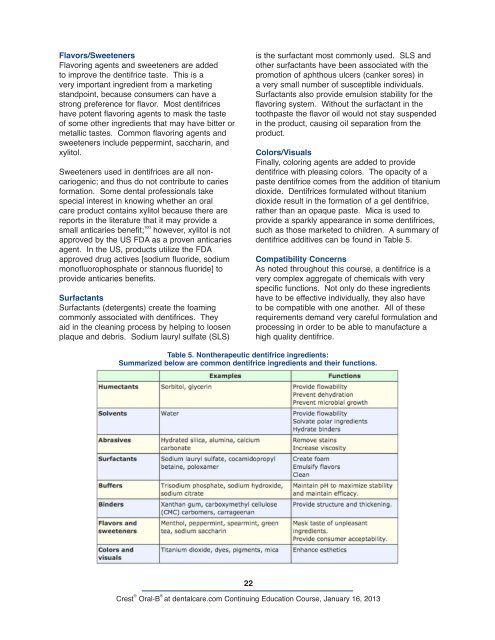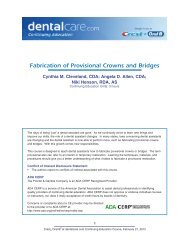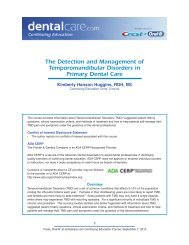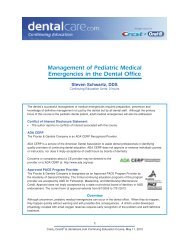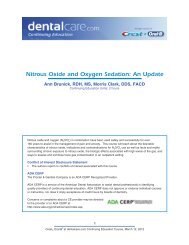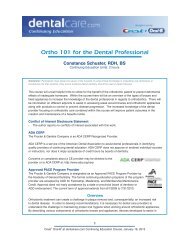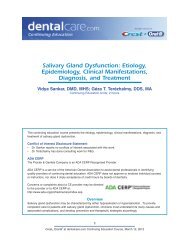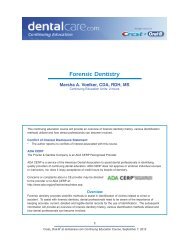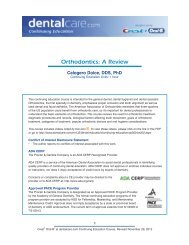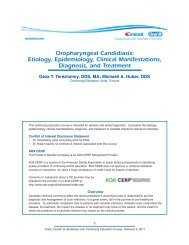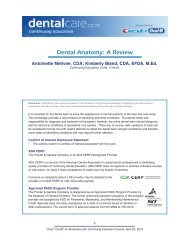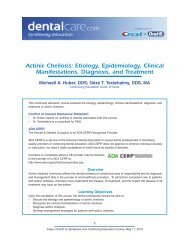CE410 - Fundamentals of Dentifrice: Oral Health ... - DentalCare.com
CE410 - Fundamentals of Dentifrice: Oral Health ... - DentalCare.com
CE410 - Fundamentals of Dentifrice: Oral Health ... - DentalCare.com
You also want an ePaper? Increase the reach of your titles
YUMPU automatically turns print PDFs into web optimized ePapers that Google loves.
Flavors/Sweeteners<br />
Flavoring agents and sweeteners are added<br />
to improve the dentifrice taste. This is a<br />
very important ingredient from a marketing<br />
standpoint, because consumers can have a<br />
strong preference for flavor. Most dentifrices<br />
have potent flavoring agents to mask the taste<br />
<strong>of</strong> some other ingredients that may have bitter or<br />
metallic tastes. Common flavoring agents and<br />
sweeteners include peppermint, saccharin, and<br />
xylitol.<br />
Sweeteners used in dentifrices are all noncariogenic;<br />
and thus do not contribute to caries<br />
formation. Some dental pr<strong>of</strong>essionals take<br />
special interest in knowing whether an oral<br />
care product contains xylitol because there are<br />
reports in the literature that it may provide a<br />
small anticaries benefit; 100 however, xylitol is not<br />
approved by the US FDA as a proven anticaries<br />
agent. In the US, products utilize the FDA<br />
approved drug actives [sodium fluoride, sodium<br />
mon<strong>of</strong>luorophosphate or stannous fluoride] to<br />
provide anticaries benefits.<br />
Surfactants<br />
Surfactants (detergents) create the foaming<br />
<strong>com</strong>monly associated with dentifrices. They<br />
aid in the cleaning process by helping to loosen<br />
plaque and debris. Sodium lauryl sulfate (SLS)<br />
22<br />
is the surfactant most <strong>com</strong>monly used. SLS and<br />
other surfactants have been associated with the<br />
promotion <strong>of</strong> aphthous ulcers (canker sores) in<br />
a very small number <strong>of</strong> susceptible individuals.<br />
Surfactants also provide emulsion stability for the<br />
flavoring system. Without the surfactant in the<br />
toothpaste the flavor oil would not stay suspended<br />
in the product, causing oil separation from the<br />
product.<br />
Colors/Visuals<br />
Finally, coloring agents are added to provide<br />
dentifrice with pleasing colors. The opacity <strong>of</strong> a<br />
paste dentifrice <strong>com</strong>es from the addition <strong>of</strong> titanium<br />
dioxide. <strong>Dentifrice</strong>s formulated without titanium<br />
dioxide result in the formation <strong>of</strong> a gel dentifrice,<br />
rather than an opaque paste. Mica is used to<br />
provide a sparkly appearance in some dentifrices,<br />
such as those marketed to children. A summary <strong>of</strong><br />
dentifrice additives can be found in Table 5.<br />
Compatibility Concerns<br />
As noted throughout this course, a dentifrice is a<br />
very <strong>com</strong>plex aggregate <strong>of</strong> chemicals with very<br />
specific functions. Not only do these ingredients<br />
have to be effective individually, they also have<br />
to be <strong>com</strong>patible with one another. All <strong>of</strong> these<br />
requirements demand very careful formulation and<br />
processing in order to be able to manufacture a<br />
high quality dentifrice.<br />
Table 5. Nontherapeutic dentifrice ingredients:<br />
Summarized below are <strong>com</strong>mon dentifrice ingredients and their functions.<br />
Crest ® <strong>Oral</strong>-B ®<br />
at dentalcare.<strong>com</strong> Continuing Education Course, January 16, 2013


